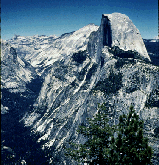Igneous Rocks, Born of Fire
 Rocks are naturally occurring solid mixtures of substances primarily made of minerals. There are three kinds of rock on earth - igneous, sedimentary, and metamorphic rock. Sedimentary rock forms from the break-down, movement, and deposition of particles from pre-existing rock. Metamorphic rock has been changed by high heat or pressure or both. Igneous rock forms when molten rock, either magma or lava, cools to a solid. Rock melted deep within the earth is called magma while it is beneath earth's surface. If it flows onto earth's surface, it is called lava.
Rocks are naturally occurring solid mixtures of substances primarily made of minerals. There are three kinds of rock on earth - igneous, sedimentary, and metamorphic rock. Sedimentary rock forms from the break-down, movement, and deposition of particles from pre-existing rock. Metamorphic rock has been changed by high heat or pressure or both. Igneous rock forms when molten rock, either magma or lava, cools to a solid. Rock melted deep within the earth is called magma while it is beneath earth's surface. If it flows onto earth's surface, it is called lava.
Intrusive igneous rock forms from the cooling of magma. Earth's heat energy causes plates to move. Plates are large sections of the solid, upper layers of the earth. (See the ScienceIQ Geology fact on Plate Tectonics from Nov. 2002.) Plate movement can force magma to move, intruding it into other rock layers by pushing them up or by breaking through and flowing between the layers. Intrusive igneous rock is insulated by the surrounding rock and cools to a solid very slowly. It may cool only a few degrees a century. Slow cooling allows time for mineral molecules to move through the liquid and collect to form large crystals. Intrusive igneous rock is only found at the surface after erosion has removed the overlying rock. Some examples of intrusive igneous rock are dark gabbros and granites of different composition and colors. Half Dome inYosemite Valleyis an intrusive granite that became exposed at the surface and was partially removed by a glacier.
Extrusive igneous rock forms when magma is forced through to earth's surface, often as a volcano. Lava flowing over the surface hardens into a dark rock called basalt. Explosive volcanoes will form pyroclasts; these include lava globules that are blown into the air where they cool. Gas escaping from lava globules can leave holes behind in the quickly solidifying rock. This can form pumice, a rock light enough to float on water, or scoria which does not float. Huge amounts of ash (very fine rock particles) can be blown high into earth's atmosphere. Ash can blanket the area around the volcano, and some may be carried by winds to other continents. Rock formed from the consolidation of ash is called tuff. Some of the exploded lava globules cool so quickly that no crystals can form resulting in a glass mineral called obsidian. The types of minerals and the sizes of crystals found in igneous rock give geologists clues to the origins of the rock.
About the Author
Claire-Jean Korzenewski, BS
 Claire-Jean Korzenewski has a B.S. in geology and experience in petroleum exploration. She is an educator with public school teaching experience in junior high and high school sciences. Claire-Jean is now a freelance writer who makes communications more effective - to inform, to educate, and to enhance profits for businesses and individuals.
Claire-Jean Korzenewski has a B.S. in geology and experience in petroleum exploration. She is an educator with public school teaching experience in junior high and high school sciences. Claire-Jean is now a freelance writer who makes communications more effective - to inform, to educate, and to enhance profits for businesses and individuals.


